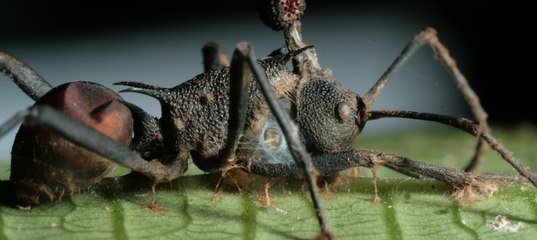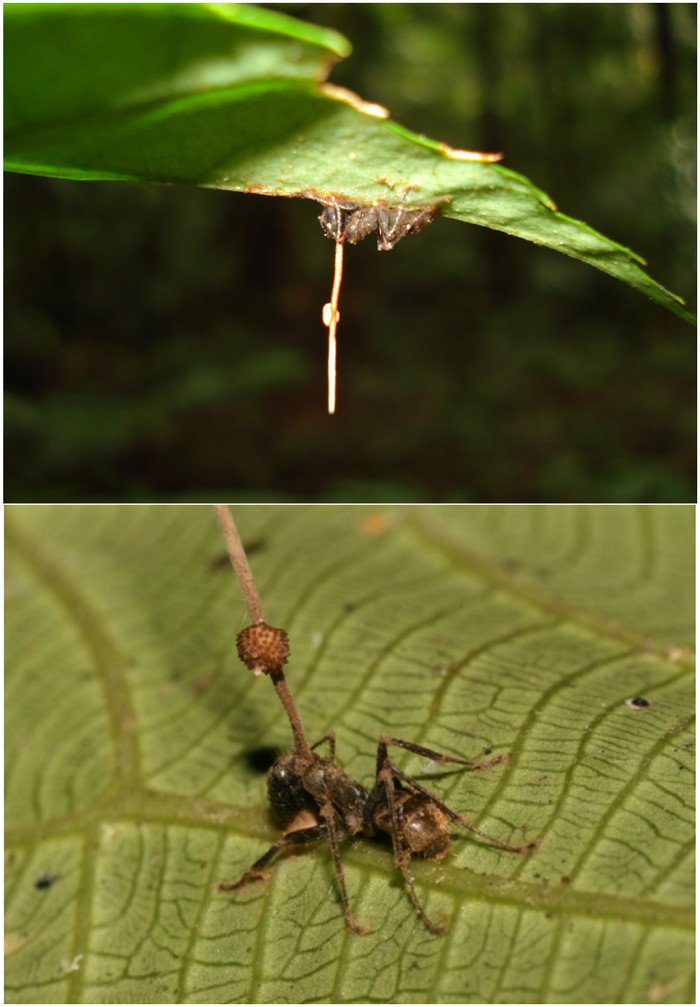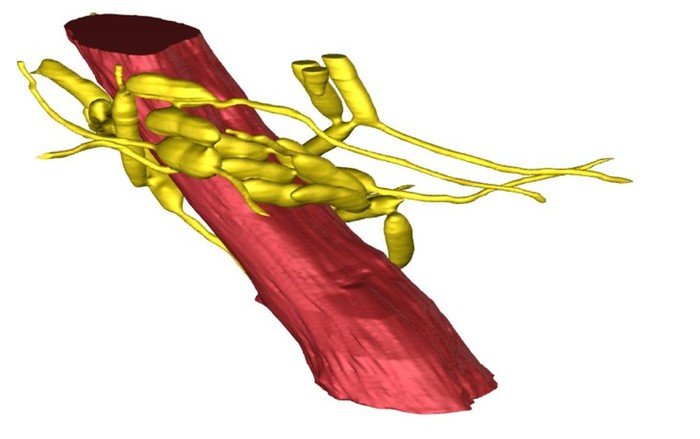
The well-known fungus turning ants into obedient zombies presented to scientists a series of surprises. It turned out that it literally grows into a body of an insect and devours his cells, doing a peculiar "meat armor" of an ant.
At the Brazilian ants carpenters already hard life is supplemented by very strange circumstance — they can turn into the most real zombies. It occurs thanks to infection with a parasitic fungus which spores sprout in a body of an insect and influence his sympathetic nervous system. Infected with a parasite, the ant leaves a cosiness of the native nest and goes to wander to a thicket which conditions are suitable a mushroom for full maturing more. Usually the ant clings pads to the lower party of a leaf then fades, thereby finally sacrificing itself. The mushroom continues to develop in his body until eventually pierces head department and will release new spores. All this process takes about 10 excruciating days for which the most part of time the insect survives. Living hell, isn't that so?

This phenomenon is known to science for a long time, however still scientists long couldn't understand, how exactly the parasitic mushroom of O. unilateralis plays the role of the puppeteer. He was often called "a brain parasite", however the new research published this week in Proceedings of the National Academy of Sciences refutes this theory. It has turned out that just the brain of an insect remains intact, and the parasite exercises control of the owner by introduction in muscle fibers on all body! In fact, the infected ant becomes some kind of "meat armor" and the vehicle for a mushroom, and a part of cells of fabrics of an ant in process are replaced with mushroom.
To make this surprising discovery, David Hughes (namely he has for the first time found a parasitic fungus) has begun an extensive research in which the international team of entomologists, geneticists, programmers and neurobiologists has participated. The purpose of work consisted in studying cellular interactions between a parasite and his owner during a critical stage of life cycle of the first — that during which the ant seizes a leaf the powerful upper jaws.
The leading author of a research, Maridel Frederiksen, the candidate for doctoral candidates at the University of the Basel zoological institute, Switzerland, has said that the fungus allocates tkanespetsifichesky metabolites in the owner's organism, causing thereby changes in an expression of genes. It also leads to an atrophy of muscles of the lower jaw of an ant that that could never unclench them any more and allow the body to fall to the ground — it would cause premature death of the owner or would put a parasite at excess risk. However, prior to work scientists didn't know, how exactly the fungus coordinates the actions that it is so dexterous to manipulate the owner's organism.

For carrying out a research scientists infected an ant carpenter of O. unilateralis. At the same time some individuals received a dose of less dangerous, not brainwashing fungal pathogen known as Beauveria bassiana — they served as a check group. Comparing dynamics of the disease caused by these two mushrooms, researchers could select specific physiological manifestations of activities of O. unilateralis at ants.
By means of electron microscopes, the group created the three-dimensional model allowing to define location, the number and activity of fungal fabrics in bodies of insects. Samples of these fabrics only 50 nanometers in size were for this purpose taken, and it was observed by means of the instruments capable to monitor and process the image with a frequency of 2000 times in 24 hours. To analyze the imposing volume of the arriving data, scientists addressed an artificial intelligence: the algorithm based on deep training during the analysis selected differences in activities of fungal and ant cells. It allowed researchers to see visually at what stage of a disease of body tissue still belonged to an insect and where were already transformed to a mushroom.
Results were at the same time extremely interesting and frightening. Cells of O. unilateralis extended on all body of an ant, from the head and chest department to a stomach and legs. Moreover, they were interconnected, creating some kind of collective biological network which controlled behavior of ants. Hughes marked that in the end the high percent of cells in an organism of the master turned into mushroom cells — that literally made an insect by a part of himself.
But the most surprising was that brain fabric remained … untouched. "Usually the behavior of animals is controlled by the brain transmitting signals to muscles, but results of our research show that the parasite controls behavior of the master by means of peripheral systems", Hughes explains. "Almost like the puppeteer pulling for threads to control movements of a puppet, a fungus also controls muscles of an ant, manipulating extremities and the master's upper jaws".
Whether the parasite can influence a brain?
It is still unknown, how exactly the mushroom forces to move an ant in the direction of a concrete leaf. Scientists believe that the fact of integrity of a brain is actually a key to the solution of a puzzle: the mushroom uses the potential of a formic brain long enough that that was alive and could find independently suitable "platform" for reproduction of a parasite. Other theory is that the mushroom indirectly influences a brain, in particular on its sensory functions "to control" ants and to force them to go to the wood.
Gaymodo Chariss de Becker, the entomologist from the University of the Central Florida who wasn't taking part in a new research is sure that the done work confirms the fact that the mushroom can control the owner by means of special secretory bonds which play a role of neurotransmitters. Point to it first of all the data obtained when studying a fungic genome.
Why it is so important for us? The comprehension of the mechanism of zombiing offers a number of prospects. First of all, it is synthesis of new biologically active compounds which can be used as potent medicines. Besides, scientists paid attention that at Ophiocordyceps kimflemingiae mushroom (a congenerous parasitic fungus) signs of activity within "biological clock" are shown: one genes of a mushroom are active in the afternoon, others — in night. Apparently, at night the mushroom activates secretion of proteins which can interact with the owner's brain, thus providing own dominance over its nervous activity. Who knows, there can be in the future a similar cocktail from implants and neurotransmitters will give us the chance to control a brain of the person and, thus, to open all his secrets?
Congratulations @shamanred! You received a personal award!
You can view your badges on your Steem Board and compare to others on the Steem Ranking
Do not miss the last post from @steemitboard:
Vote for @Steemitboard as a witness to get one more award and increased upvotes!